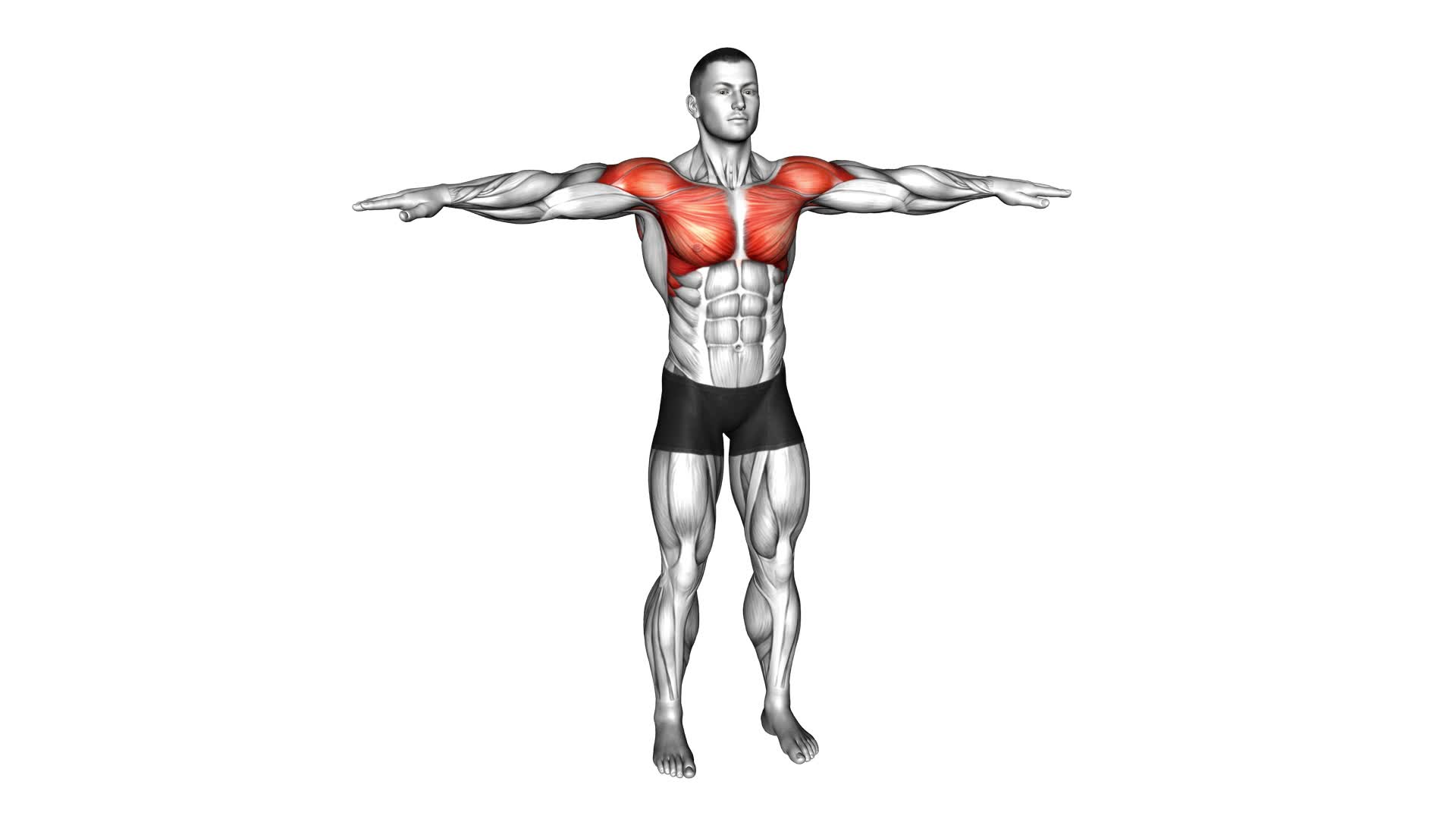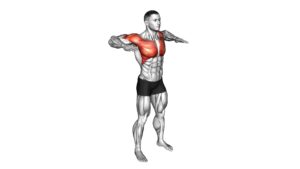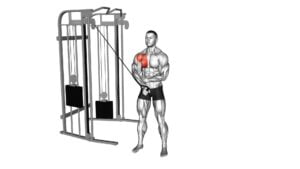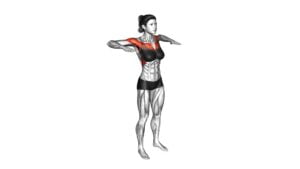Arm Crossover (male) – Video Exercise Guide & Tips

Looking to strengthen and tone your arms? Look no further than the Arm Crossover exercise!
Watch This Exercise Video
In this video exercise guide, we'll show you the proper form and technique, variations for progression, and common mistakes to avoid.
Plus, we'll share some valuable tips to maximize your results.
Whether you're a beginner or advanced, this exercise is perfect for you.
Grab your dumbbells and get ready to feel the burn!
Key Takeaways
- Arm crossover exercise improves flexibility and increases range of motion in the shoulders and chest.
- It strengthens and tones chest muscles, improving posture and body awareness.
- Proper form and technique, such as keeping the shoulders relaxed and engaging the core for stability, are crucial for maximizing results and preventing injury.
- Variations and modifications, such as increasing weight or tempo, can be used to progress the exercise and target different muscle groups.
Benefits of Arm Crossover Exercise
What are the benefits of performing the Arm Crossover exercise?
The Arm Crossover exercise is a great way to improve flexibility and target your chest muscles. This exercise involves crossing your arms in front of your body and then opening them wide, working the muscles in your chest.
By performing this exercise regularly, you can increase the range of motion in your shoulders and chest, leading to improved flexibility. Additionally, the Arm Crossover exercise specifically targets your chest muscles, helping to strengthen and tone them. This can be beneficial for both men and women who want to enhance their upper body strength and appearance.
The exercise can also help to improve posture by strengthening the muscles that support the shoulders and upper back.
Proper Form and Technique
To ensure proper form and technique during the Arm Crossover exercise, it's crucial to focus on alignment. Keep your shoulders relaxed and down, and engage your core to maintain stability.
Avoid common mistakes such as rounding your back or hunching your shoulders, as this can lead to improper muscle activation and potential injury.
Stay mindful of your form and make adjustments as needed to maximize the effectiveness of the exercise.
Importance of Alignment
Maintain proper alignment throughout the Arm Crossover exercise by keeping your shoulders square and your core engaged. Alignment is crucial for maximizing the benefits of this exercise and avoiding form mistakes that can lead to injury. Here are four reasons why alignment is important:
- Improved efficiency: When your body is properly aligned, you can perform the exercise with greater efficiency, allowing you to get the most out of each repetition.
- Reduced risk of injury: Proper alignment helps distribute the workload evenly across your muscles, reducing the risk of strain or injury.
- Enhanced muscle engagement: By maintaining alignment, you ensure that the target muscles are being properly engaged, leading to better muscle activation and development.
- Better posture and body awareness: Consistently practicing proper alignment during exercises like the Arm Crossover can help improve your overall posture and body awareness, carrying over into your daily activities.
Common Mistakes to Avoid
To ensure proper form and technique during the Arm Crossover exercise, it's important to be aware of common mistakes and how to avoid them.
One common mistake to avoid is improper breathing. Many people tend to hold their breath during this exercise, which can lead to increased tension and reduced effectiveness. Remember to breathe steadily throughout the movement, inhaling as you raise your arms and exhaling as you cross them over.
Another common misconception is using excessive momentum. It's crucial to focus on controlled movements and not rely on swinging or jerking your arms. This will help target the intended muscles and prevent any potential injuries.
Variations for Progression
To further challenge yourself and continue progressing with the Arm Crossover exercise, there are a few variations you can try.
One way to increase the difficulty level is by using heavier weights.
You can also modify the arm positions by crossing them lower or higher, targeting different muscles in your shoulders and chest.
Increasing Difficulty Levels
To progress in difficulty levels for the arm crossover exercise, try incorporating variations that challenge your muscles in new ways. Here are some advanced modifications to take your workout to the next level:
- Increase the weight: Gradually add more resistance by using heavier dumbbells or resistance bands. This will further engage your muscles and make them work harder.
- Add a balance challenge: Perform the arm crossover exercise while standing on one leg or on an unstable surface like a balance board. This won't only target your upper body but also improve your stability and core strength.
- Speed it up: Increase the tempo of the exercise by performing quick and controlled movements. This will add an element of cardiovascular endurance to your workout.
- Incorporate plyometrics: Combine the arm crossover exercise with explosive movements like jumping or hopping to increase power and intensity.
By incorporating these variations, you can continuously challenge yourself and take your arm crossover exercise to new heights.
Now, let's move on to the next section about modified arm positions.
Modified Arm Positions
Try different arm positions to progress the arm crossover exercise and challenge your muscles in new ways. By modifying your arm positions, you can add variety and intensity to your workout.
One variation you can try is extending your arms fully out to the sides, parallel to the ground, while performing the crossover motion. This modification engages your shoulder muscles more intensely and increases the difficulty of the exercise.
Another option is to experiment with creative arm movements such as circling your arms or pulsing them up and down as you cross them over. These modifications not only target different muscle groups but also keep your workout interesting and prevent plateaus.
Common Mistakes to Avoid
Avoid these common mistakes when performing the arm crossover exercise to ensure proper alignment and maximize its effectiveness:
- Crossing your arms too forcefully: While it may be tempting to generate momentum by forcefully crossing your arms, this can lead to strain or injury. Instead, focus on controlled movements and engage your core muscles for stability.
- Allowing your shoulders to hunch: Keep your shoulders relaxed and down throughout the exercise. Hunching your shoulders can put unnecessary strain on your neck and upper back. Maintain a tall and upright posture to avoid this mistake.
- Neglecting proper breathing: Remember to breathe throughout the exercise. Holding your breath can increase tension and make the movement less efficient. Inhale as you prepare for the crossover and exhale as you perform the movement.
- Rushing through the exercise: Take your time and perform the arm crossovers with deliberate and controlled movements. Rushing through the exercise can compromise your form and reduce its effectiveness. Focus on quality rather than quantity.
Tips for Maximizing Results
To maximize your results, focus on maintaining proper form and engaging your muscles throughout the arm crossover exercise. Proper form and technique are crucial for targeting the right muscles and preventing injuries. Start by standing with your feet shoulder-width apart and your knees slightly bent. Keep your core engaged and your back straight throughout the exercise.
As you bring your arms across your body, make sure to keep them at shoulder level and fully extend them to the sides. This will help engage your chest and shoulder muscles effectively. Avoid swinging your arms or using momentum to complete the movement. Instead, focus on controlled and deliberate motions.
Another way to maximize your results is by incorporating workout progressions. Once you have mastered the basic arm crossover exercise, you can increase the resistance by using dumbbells or resistance bands. This will challenge your muscles and help you build strength and endurance. You can also try variations of the exercise, such as performing it on an unstable surface like a Bosu ball or adding a twist at the end of each rep. These progressions will keep your workouts challenging and prevent plateaus in your progress.
Remember to always listen to your body and adjust the intensity and difficulty level accordingly. By maintaining proper form, engaging your muscles, and incorporating workout progressions, you can maximize the results of your arm crossover exercise and achieve your fitness goals more efficiently.
Sample Arm Crossover Workout Routine
To incorporate the arm crossover exercise into your workout routine, consider the following sample workout plan:
- Start with a dynamic warm-up to prepare your muscles for the workout.
- Perform 3 sets of arm crossovers, with 10-12 repetitions per set.
- Rest for 30 seconds between each set to allow your muscles to recover.
- After completing the arm crossover exercise, move on to other upper body exercises such as push-ups, shoulder presses, or bicep curls.
By incorporating arm crossovers into your workout routine, you can target your chest, shoulders, and arms while improving your overall upper body strength.
To add variety and challenge to your workouts, you can try different arm crossover variations such as alternating arm crossovers, single-arm crossovers, or resistance band crossovers.
Additionally, if you find the exercise too difficult, you can modify it by using lighter weights or performing the exercise without weights altogether.
Remember to always listen to your body and adjust the intensity of the exercise according to your fitness level.
With consistent practice and proper form, you can maximize the benefits of the arm crossover exercise and achieve your fitness goals.
Frequently Asked Questions
How Many Calories Does the Arm Crossover Exercise Burn?
The arm crossover exercise is a great way to burn calories and work your upper body muscles.
By incorporating different arm crossover variations, you can target different muscle groups and increase the intensity of your workout.
This exercise not only helps you burn calories, but it also improves your posture, strengthens your shoulders and chest, and enhances your overall upper body strength.
Can Arm Crossover Help in Reducing Shoulder Pain?
Arm crossover exercise can be beneficial in reducing shoulder pain. By engaging the muscles in your upper body, this exercise helps improve shoulder mobility and strengthen the surrounding muscles.
Athletes can also benefit from arm crossover modifications that focus on increasing range of motion and targeting specific muscle groups.
Regularly incorporating arm crossover into your workout routine can help alleviate shoulder pain and improve overall shoulder strength and flexibility.
Is It Safe to Perform the Arm Crossover Exercise With Weights?
Performing the arm crossover exercise with weights can be safe as long as you use proper form and start with light weights.
However, if you have any shoulder or joint issues, it's best to consult with a professional before adding weights.
It's also important to note that the arm crossover exercise can still be beneficial without weights.
You can modify the exercise by using resistance bands or simply focusing on the movement and engaging your muscles without any added weight.
Does Arm Crossover Help in Improving Posture?
Arm crossover is a great exercise for improving your posture. It helps strengthen your upper body muscles, which play a vital role in maintaining proper alignment.
To perform it correctly, stand tall with your feet shoulder-width apart. Hold a dumbbell in each hand and raise your arms out to the sides. Then, cross one arm over the other, alternating sides.
This movement targets your chest, shoulders, and back, helping you achieve better posture and overall upper body strength.
Can Arm Crossover Exercise Be Done as a Warm-Up Before Other Upper Body Workouts?
Yes, arm crossover exercise can be done as a warm-up before other upper body workouts. It helps to activate and warm up the muscles in your chest, shoulders, and upper back. By crossing your arms in front of your body and then opening them wide, you can increase blood flow to these areas and improve mobility.
Additionally, arm crossover modifications can be made by using resistance bands or weights to add intensity and challenge to the exercise.
Conclusion
In conclusion, the arm crossover exercise is a great way to strengthen and tone your upper body muscles. By following proper form and technique, you can maximize the benefits of this exercise.
Additionally, varying the intensity and incorporating different variations can help you progress and challenge yourself. Avoiding common mistakes and implementing the tips provided can further enhance your results.
Consider incorporating the arm crossover exercise into your workout routine for a stronger and more defined upper body.

Author
Years ago, the spark of my life’s passion ignited in my mind the moment I stepped into the local gym for the first time. The inaugural bead of perspiration, the initial endeavor, the very first surge of endorphins, and a sense of pride that washed over me post-workout marked the beginning of my deep-seated interest in strength sports, fitness, and sports nutrition. This very curiosity blossomed rapidly into a profound fascination, propelling me to earn a Master’s degree in Physical Education from the Academy of Physical Education in Krakow, followed by a Sports Manager diploma from the Jagiellonian University. My journey of growth led me to gain more specialized qualifications, such as being a certified personal trainer with a focus on sports dietetics, a lifeguard, and an instructor for wellness and corrective gymnastics. Theoretical knowledge paired seamlessly with practical experience, reinforcing my belief that the transformation of individuals under my guidance was also a reflection of my personal growth. This belief holds true even today. Each day, I strive to push the boundaries and explore new realms. These realms gently elevate me to greater heights. The unique combination of passion for my field and the continuous quest for growth fuels my drive to break new ground.







